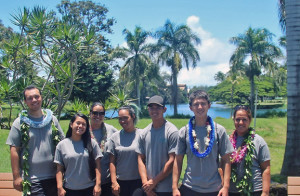
Left to right: Halena Kapuni-Reynolds, Tusie’ana Berrios, Aoloa Santos, Natalie Keawekane, Caleb Akau, Craig Okahara-Olsen, Lokelani Brandt. Photo courtesy of the Wahi Kupuna Internship Program.
Unbeknownst to many of us, a number of bright young local high school and university students have been conducting research into aspects of the history of Pi‘opi‘o, one of Hilo’s wahi pana (legendary places). Under the auspices of the Wahi Kupuna Internship Program, these young scholars have undergone training in both the cultural and technical sides of cultural resource management, learning to become stewards of significant places that are valued and cared for collectively by their respective communities.
Tonight, five of these remarkable students share their findings with us: On the history of Pi‘opi‘o; environmental issues facing the Wailoa River Estuary; the traditional practice of planting taro in mounds along marshy river banks; the use of “repeat photography” to analyze changes in the Pi‘opi‘o landscape following the 1946 tsunami; and the importance of interpretive signage in the Pi‘opi‘o area. We at the Lyman Museum are truly impressed with the scope and quality of these projects, and equally so with the demonstrated ability of these young people to contribute to our understanding of the cultural and historical environment. They represent so much of their generation’s potential to learn and to teach about the world around them; you won’t want to miss this opportunity to appreciate what they have to offer all of us, now and in the future.
Free to Lyman Museum members; $3 nonmembers.
Doors open at 6:30 p.m. for evening public programs.
Limited seating; first come, first seated.
Additional parking next door at Hilo Union School.
